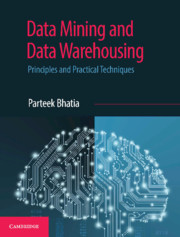Book contents
- Frontmatter
- Dedication
- Contents
- List of Figures
- List of Tables
- Preface
- Acknowledgments
- 1 Beginning with Machine Learning
- 2 Introduction to Data Mining
- 3 Beginning with Weka and R Language
- 4 Data Preprocessing
- 5 Classification
- 6 Implementing Classification in Weka and R
- 7 Cluster Analysis
- 8 Implementing Clustering with Weka and R
- 9 Association Mining
- 10 Implementing Association Mining with Weka and R
- 11 Web Mining and Search Engines
- 12 Data Warehouse
- 13 Data Warehouse Schema
- 14 Online Analytical Processing
- 15 Big Data and NoSQL
- Index
- Colour Plates
6 - Implementing Classification in Weka and R
Published online by Cambridge University Press: 26 April 2019
- Frontmatter
- Dedication
- Contents
- List of Figures
- List of Tables
- Preface
- Acknowledgments
- 1 Beginning with Machine Learning
- 2 Introduction to Data Mining
- 3 Beginning with Weka and R Language
- 4 Data Preprocessing
- 5 Classification
- 6 Implementing Classification in Weka and R
- 7 Cluster Analysis
- 8 Implementing Clustering with Weka and R
- 9 Association Mining
- 10 Implementing Association Mining with Weka and R
- 11 Web Mining and Search Engines
- 12 Data Warehouse
- 13 Data Warehouse Schema
- 14 Online Analytical Processing
- 15 Big Data and NoSQL
- Index
- Colour Plates
Summary
Chapter Objectives
✓ To demonstrate the use of the decision tree
✓ To apply the decision tree on a sample dataset
✓ To implement a decision tree process using Weka and R
Building a Decision Tree Classifier in Weka
In this chapter, we will learn how Weka's decision tree feature helps to classify unknown samples of a dataset based on its attribute values. When Weka's decision tree is applied to an unknown sample, the decision tree classifies the sample into different classes such as Class A, Class B and Class C as shown in Figure 6.1.
For example, if we want to predict the class of an unknown sample of a flower based on the length and width dimensions of its Sepal and Petal. The first step would be to measure Sepal length and width and Petal length and width of an unknown flower and compare these dimensions to the values of the samples in our dataset of known species. The decision tree algorithm of Weka will help in creating decision rules to predict the class of unknown flower automatically as shown in Figure 6.2.
As shown in Figure 6.2, the dimensions of an unknown sample of flower will be matched with the rules generated by the decision tree. First, the rules will be matched to determine whether the sample belongs to Setosa class or not, if yes, the unknown sample will be classified as setosa. If not, the unknown sample will be checked for being of the Virginica class. If it matches with the conditions of the Virginica class, it will be labeled as Virginica, otherwise Versicolor. It is important to note that it would not be simple to create these rules on the basis of the values of single attribute as shown in Table 6.1. It is clear that for the same Sepal width, the flower may be of Setosa or Versicolor or Virginica, making it unclear which species an unknown flower belongs to on the basis of Sepal width alone. Thus, the decision tree must make its prediction based on all four flower dimensions.
Due to such overlaps, the decision tree cannot predict with 100% accuracy the class of flower, but can only determine the likelihood of an unknown sample belonging to a particular class. In real situations the decision tree algorithm works on the basis of probability.
- Type
- Chapter
- Information
- Data Mining and Data WarehousingPrinciples and Practical Techniques, pp. 128 - 154Publisher: Cambridge University PressPrint publication year: 2019



